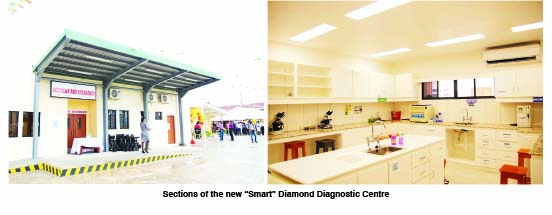Home Top Stories Diamond Diagnostic Centre commissioned as a smart facility
The Diamond Diagnostic Centre has been commissioned as a smart hospital, equipped with resources to mark its resiliency against climate threats and enable sustainable operation. 
The “Smart Hospital” concept comes under an $835 million fund by the former United Kingdom Department for International Development and implemented by the Pan American Health Organisation’s Department of Emergency Preparedness and Disaster Relief with the Health Ministry.
Four other hospitals at Leonora, Mabaruma, Paramakatoi and Lethem are to be upgraded under this project. It addresses the negative footprints that contribute to climate change by simply modifying operations.
Works at the Diamond Diagnostic facility was completed to the tune of US$984,439 and can now cater for emergency services, obstetrics, gynaecology, surgeries, paediatrics, orthopaedics, pharmacy and laboratory services among others.
Health Minister, Dr Frank Anthony indicated at Saturday’s handing over ceremony that the introduction of energy-efficient systems will lift the dependence on traditional power sources. A mechanism was installed to collect rainfall and repurpose the water for daily operations.
“We can generate much of our own power here at the hospital. We have done so by putting in a state-of-the-art solar system that would be able to power most of the equipment that we have in the hospital. By doing so as well, one of the by-products of this or the side-effects of this is that we wouldn’t have to pay so much electricity bill,” he expressed.
The decentralised location will ease the strain from the Georgetown Public Hospital to provide key services.
“We hope that by reopening, more people would utilise these services and we would not crowd up the services that we have at Georgetown Hospital. This hospital will be manned by 58 nurses and we have 20 doctors that will be working here,” he stated.
Another 89 medical facilities across the country underwent assessments and with any new infrastructural works, the focus will be placed on creating climate-resilient structures.
Deputy British High Commissioner, Ray Davidson alluded to the extant coronavirus pandemic that has realised the need for contingency plans. The new facilities will require continued maintenance in order to efficiently function in any setting.
“COVID-19 has further highlighted the importance of disaster preparedness and contingency measures that help facilities, for staff and patients. The improvements will require careful and timely maintenance in order that they will continue to operate and deliver their services most effectively.”
He added, “Sadly, we have all seen firsthand the impact that this dreadful virus has had on the world…The smart hospital programme mantra is smart equals safe plus green plus maintenance. We can now align effectively, practically our political work and development work and our humanitarian work.”
The building has been redesigned to use less electricity and water, along with other retrofitting to reduce disaster vulnerabilities. PAHO Representative, Dr Luis Codina highlighted that functionality was also targeted to support the structural makeup.
“While the retrofitting mainly focused on the structural aspect, we now focus on the functional aspects and the role of the staff is very important in this regard…Another aspect of the project is the capacity building initiative. Training has been provided to various sectors including building professionals, public servants and private sector individuals.” (G12)
